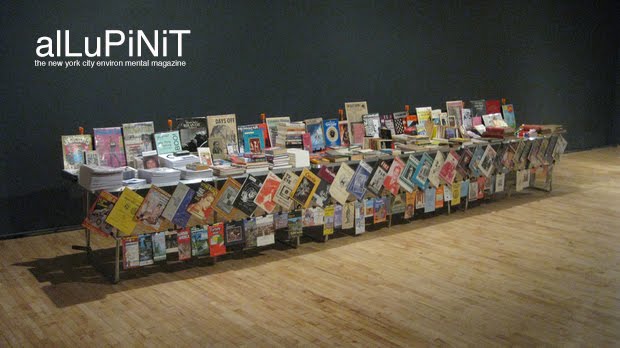
Artists Rafael Sánchez ( b. Havana, Cuba 1960 ) and Kathleen White ( b. Fall River, Mass.1960 )are partners and collaborators living and working in New York City. They met through their affiliation with Participant Inc where they each had one person exhibitions in 2004. Their TABLE project, an ongoing outdoor book record tape vending project has been featured through various incarnations in a variety of articles and exhibitions including Bouble-Bill at Art in General in 2010. In 2011 their Somewhat Portable Dolmen was a nomadic feature in El Museo del Barrio’s biennial The (S) Files. The artists are founders and co-editors of alLuPiNiT , the new york city environ mental magazine, which was featured in 2012 at the Museum of Modern Art exhibition Millennium Magazines. Mr. Sánchez’ Tracings, drawings from the TABLE, will be featured in Visual AIDS’ 25th year anniversary exhibition, Not Over in July 2013. Ms. White and Mr Sánchez have referred to their process as “the playful intersection of research, poetry and a private theater revealed through works of urban gardening.”
Q. Tell me about your journey as
artist?
A. Each artist, if they work
collaboratively is an individual. You
create objects. You create things. But
you have to be comfortable with the
idea of letting go. At some point you
have to release yourself in the world.
In that respect, artists have to be very
comfortable with a shifting concept of
what ownership means.
Q. Do you feel people are resistant to
sharing?
A. I wouldn’t say people are resistant.
I think people like the idea of
permission. There is a tug of war as
it pertains to ownership and part of
that is being asked for the rights to
something. In a simple way, it’s just
nice to be asked whether you can use
something that belongs to someone
else rather than just taking it.
Q. How does copyright effect artist?
A. Well it’s interesting, visual artist lack
the ability to copyright in the same
way that other type of artist can. A
visual artist has to be comfortable with
the idea of loss. I have ownership
perhaps during the process of creation
but after that I have to put it into the
world. That’s the whole point. At what
point is it inspiration and is strictly
used for someone’s gain. Copyright
is a hard line in the sand that doesn’t
apply in the same way to what we
visual artist do.
Q. How do you balance this idea of
continuous loss when it comes to your
work?
A. Figuring out the balance of living
with your creativity in this world is a
better way to think of it than loss. The
idea of art is similar to a flower…
once a flower blossoms and is out
in the world..then it is subject to the
elements…physical dangers and
societal perils….and also the benefit
of those things i.e. love….the best
thing an artist can hope for is that the
work can be shared and taken care
of i.e. museums and institutions….most
art blossoms in the elements…whether
those elements are good or bad they
are part of the process.
Q. When you mention the beneficial
elements it sounds like you are
invoking elements of stewardship.
A. I think I am. The type of benefit that
comes from the elements is part of
stewardship. Taking care of the work
and valuing it for those that come
after you. Gaudi’s work is a great
example of that. He set the wheels in
motion for this incredible work of art,
this monument. Each year over likely
generations artists, builders continue
to add to his vision. They change it,
alter it, but their contribution serves to
protect it in many ways.
Q. Is there an example of this in your
current work?
A. Yes, definitely. We have two great
examples. One is informal, which is
our book project. Every so often we
set up a vendor’s stand outside our
gallery and sell some really interesting
books. Many of them are beautiful
and are works of art in their own
respect. But we have so many and
the goal is not to hoard them but to
take from the, chart our time with them
and then release them. In many ways
we are the stewards of these books.
We actually trace images from the
books and keep them. So in many
ways we have lingering ghosts if you
will of these amazing books that serve
as a reminder of their time here with
us. The other more formal project is
our Somewhat Portable Dolmen, which
is a moving installation project. We
have had the Dolmen in museums,
punk concerts and even Times Square
and in each environment people
respect the Dolmen. Even if they don’t
understand it there is a curiosity there
and they are stewards of our work in
the way they interact with it.
Q. Do artist play a special role in the
idea of stewardship and ownership?
A. Artists are big influencers in
the movement of space and by
extension of ownership. Influencers
lend their value and there is a high
price being paid for influence. It
isn’t just about participation but it is
about the conversation that is being
had around these ideas. In many
ways the artist being strictly paid for
their contribution is the old way of
doing things and it is not a reliable
model. It is the conversation about
the object about the artwork that lasts
beyond the physical object itself. It
is the conversation that is important
and must be sustained and that is
dependent on stewardship. For the
artist to be sustained their work must
be stewarded from one point to the
next at the end of the day the object is
merely symbolic.
<>
Philip L. McKenzie is a writer,
Founder/Global Curator of Influencer Conference
for the full FutureMark PDF click :
